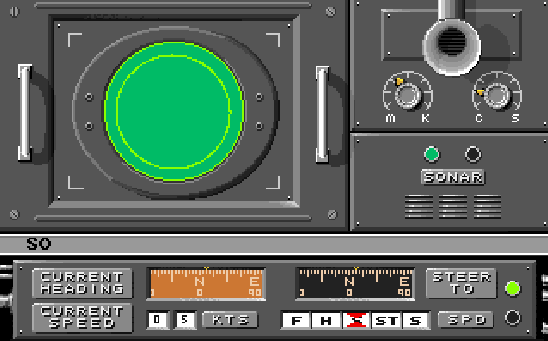 11-26-08, 10:14 AM
11-26-08, 10:14 AM
|
#3
|
|
Born to Run Silent
Join Date: Jan 1997
Location: Cougar Trap, Texas
Posts: 21,293
Downloads: 534
Uploads: 224
|

Quote:
|
Originally Posted by Sonarman
my first naval game the legendary "Destroyer" from Epyx
|
Right! Destroyer

About the game:
Quote:
Destroyer is a naval combat simulation computer game released by Epyx in 1986[1]. It was released on several platforms, including the Amiga, Apple II, Apple IIGS, Commodore 64, and IBM-compatible PCs. Destroyer put the player in the role of captain of a Fletcher-class Destroyer in the Pacific theatre during World War II. The player could choose to undertake a number of different naval warfare operations, including hunting submarines, torpedoing enemy ships, fighting off airplane attacks, bombarding island installations, rescuing stranded allies, and escorting cargo vessels through enemy waters. The game used both joystick and keyboard controls. The keyboard was used to switch between several different screens, each representing a section of the ship.
Sections included
Bridge - A series of switches used to alert stations of status or turn on certain automated functions, such as pursuant or evasive action.
Navigation - A map of the sea where the ship was, with the ability to chart specific courses.
Observation Deck - A 360-degree view of the ocean around the ship.
Radar - A sweeping radar screen indicating the presence of enemy planes.
Sonar - A sonar screen indicating the presence of enemy submarines.
Guns Forward/Guns Aft - Two separate locations on opposite ends of the ship, each with a set of long-range guns for firing on enemy ships and island locations.
Anti-Aircraft Guns Port/Starboard - Two separate locations on opposite sides of the ship, each with a set of anti-aircraft guns for firing on enemy planes.
Torpedoes Port/Starboard - Two separate locations on opposite sides of the ship, each with a set of torpedoes for firing on enemy ships.
Depth Charges - A location for dropping explosive charges to attack enemy submarines.
Damage Control - An overview of the ship to see what sections had been damaged by enemy attacks and to what extent the damage affected them.
In each screen, the joystick is used to control the functions within that screen; for example, directing the heading and speed of the ship, or aiming and firing guns. Only one screen can be controlled at any one time; however, there is an informational ticker along each screen where certain stations could report informational updates, such as if enemy planes or submarines are sighted. Each mission was played in real-time, so the choice of screen at any given time is important, and switching between them rapidly is part of the strategy.
Attacks from enemies can disable any screen at any time. If a certain area of the ship is damaged by an enemy attack, the player can still access the screen, but all or part of the functions of that screen may be unresponsive. For example, if any of the weapons are damaged, they may not fire at all, or they may still fire but may not be able to be properly aimed. Damage to the navigation area causes the ship to sail uncontrollably in random headings. As battles progress, repairs—over which the player has no control—may restore functions. Some weapons have certain limitations that if reached could cause damage as well; anti-aircraft guns, for example, can overheat if fired continuously for too long, rendering them inoperable until they cool down. If the ship was to sustain too much damage in the course of a mission (or in certain other circumstances, such as running aground on an island), the ship was deemed sunk and the mission was a failure. Players also had the option of sending an "abandon ship" message, but in terms of gameplay, the result was the same as a sunken ship.
|
Three in a row for Sonarman, and the rest of the guys are sitting on their hands 
Neal
|

|
|